Research Article - (2021) Volume 0, Issue 0
Separation and Method of Natural Pigments by Chromaticity Transformation of Green Seaweed
Man Gil Ahn*Abstract
Green algae are distributed in various parts of the world and live on rocks and stones in coastal waters. And it is a green alga that can be seen in the four seasons in the area where the sea meets the river. Korea has four distinct geographical seasons and uses the sea, land, and experimental bottles to observe and investigate the structural colors and characteristics of green algae and the transformation of chromaticity in the seasonal environment of nature. Green algae have nine pigments genetically and seasonally change color due to UV light and temperature.Green algae (Chlorophyll-a and b) have pigments (green, blue, yellow, white, scarlet, red, red, brown, and black). According to genetic information in mitochondria, cell pigments are signal-transmitted, directing and determining cell pigments, and the colors of cells are physiologically subject to regular or irregular color synthesis due to UV effects.We found that various colors of green algae were followed by a chromatic transformation in some environments and conducted various observations and experiments.The colorimetric transformation of green algae in the ocean occurs frequently in summer seasonally and irregularly when exposed to ultraviolet light at high and low sea levels.On the ground, seasonal changes in the chromaticity of green algae appeared regularly, and they sometimes appeared irregularly.Changing from green to white is a strong ultraviolet or temperature effect.Green algae turning yellow is the influence of ultraviolet light at the top of the sea water.Green algae turning scarlet is white to pink and appears in seawater.The change of green algae to red appears as a transformation of scarlet to chromaticity.The transformation of green algae into red purple appears in the transformation and process of red chromaticity.The transformation of green algae into reddish brown occurs during the transformation of red purple to chromaticity.The change of green algae to brown appears as a transformation of chromaticity from reddish brown.The turning of green algae into black appears to be black due to the occurrence of acid volatile sulfide in contaminated seawater.The blue color of green algae appears bright blue as moisture evaporates, and in green and blue, they appear blue.The appearance of green algae in purple is attributed to the effects of red purple and brown.In other words, the structural colors of green algae can be transformed from light to dark in color and produce a variety of more pigments.The main production and study of natural blue pigments over a long period of time is cyanobacterium arthrospira (Spirulina) platensis, which is responsible for the production of one of the blue compounds of eukaryotic algae as metal oxides, animals, plants and marine microorganisms.Recently, there are indigo dine pigments by extracting pigments of yttrium, indium, manganese metal compounds, and bacteria used as cosmetics, which are produced for industrial use as blue pigments.Despite this development, there has been no study of blue pigments in marine green algae, and interest in these products is very high because there is no stable natural blue pigments in nature.We are the first in the world to identify the structural colors and chromatic transformations of green algae as marine life.We developed technology and research on natural pigments in the future, enabling the foundation for mass production. This study focused on the characteristics of green algae and the production of blue pigments, which can be an important source of blue pigments, along with potential applications in the cosmetics and food industries and other industries.
Keywords
Green algae, Green seaweed, Chromaticity transformation, Pink and blue pigments, Anthocyanins, Fresh water, Nine colors andpigments, Mitochondria, Dried algae.
Introduction
Dyes and pigments are colors derived from nature that have been around for centuries and are the foundation of all industries today. The dye and pigments industry is an industry that implements color in all industries and is mainly used for a variety of industries, including oil paints, ink, paint, plastic, textile, electronics, cosmetics, and automotive industries. Natural pigments are obtained from natural plants and include flowers, leaves, fruits, and stems. Inorganic pigments are metal oxides that are produced by reacting with emulsions, chloride, and sulfates, including Fe, Zn, Ti, Cd, As, Co, Mg, Al, Cr, In, and Mn. Organic pigments are the first product to be synthesized in 1856, and in 1858 when Griess discovered a reaction between diazonium salts and azocoupling, resulting in the synthesis of many different azocene pigments, which is today the basis for the synthesis of organic pigments. With the development of Brillant Carmane GB in 1903, Lake Red 4R in 1905, Fast Yellow in 1908, and Diazo Yellow in 1911, springtime industrialization of organic pigments began. In 1928, new organic pigments of Phthalocyanine Blue Quinacridone, Diketopyrrolopyrrole (DPP) were developed. Despite the rapid development of the dye and pigmentation industries today, the toxic effects of cyanide compounds on coastal rivers and sea water ecosystems are becoming very serious. And as a toxic heavy metal, toxic substances such as arsenic, hexavalent chromium, cadmium, mercury, and lead continue to occur, destroying the global ecological environment.
Blue pigments in metal
Basic Conceptual Society and Source for COBALT BLUE the blue color of the azulejo glaze is obtained from refined cobalt oxides from ore containing several different metals and quasi-metals.The cobalt itself, the most common ore, and the cobalt oxide directly obtained from them are gray or pink.The blue color of the glaze is the result of the cobalt-oxygen group formed when the chemical structure of silica was created in the presence of alkali oxides acting as oxygen sources to form chemical blocks.It should be remembered that blue is not visible in cobalt-rich ore.Cobalt was early Egypt, Persia, Rome... It was found in glass, but rarely.Old blue glass beads could be "recycled" and used as pigments for new glass.In the Middle Ages, sources of 1, 2, or three cobalt were known in East Asia (one or two in China, perhaps one in Sumatra), but the pigment used in Chinese pottery did not reach Europe.By about 1500 years, at least one known pigment in Persia had reached Europe.Iraq could have a second source of cobalt pigment. Samarra, where the first tin glaze (from the 9th to 10th centuries AD) was discovered in archaeological context.Before 1500, at least two cobalt pigments with different associations.Both had little or no arsenic in their composition, but one of them was high in nickel and the other had only a trace of Ni.Nickel content is easier to see.Because it darkens blue in a very undesirable way. Also, the blue pigments acquired in the 16th, 17th or 18th centuries to paint azulejos were actually small (at least silica and alkali oxides) obtainedbyfir"Cobalt" was not known until the 1700s.Cobalt often occurs in arsenic-bound nature, such as in cobalt tights (CoAsS), saflorite (CoAs2) and scooter Ludite (CoAs3). Linnaeite (Co3S4) in Sweden and other regions is an acobalt sulfate that occurs in series with polydimite (cobalt is replaced by).Nickel) None of which contains arsenic Most importantly, cobalt-containingor often contains nickel, iron, copper, bismuth... Its association with other metals and quasi-metals can be particularly characteristic and help pinpoint the source of cobalt used as pigments in some areas.(Origin, early history and technology of the blue pigment in azulejosJoão Manuel MimosoLaboratórioNacional de Engenharia Civil, LNEC, Lisbon, Portugal.)
Blue pigment in nature
Blue is a very noticeable color on Earth. But blue is very rare when it comes to nature.Less than one in ten plants has blue flowers and much fewer animals are blue.Blue flowers are rare in plants, but few have green leaves except for a few plants found at the bottom of the rainforest. The main reason for this is related to the physics of light. Pigments appear as light colors that reflect without absorbing them. The most common plant pigment is green chlorophyll, so chlorophyll does not absorb green light, but rather reflects it, so the plant looksgreen. However,plants like blue light because they have more energy than any other light in the visiblespectrum.Animals are much more difficult to turn blue.Many pigments in animals come from the food they eat. Soflamingos are pink because of the dye they get when they eat shrimp, their favorite food, and goldfish's golden color comes out as food. However, as we heard above, animals cannot turn blue through food because plants do not have true blue pigments.Blue is obtained from many animals by creating structures that change the wavelength of light instead of mixing orchanging pigments. For example, a blue moto butterfly gains color by having its wing scales shaped like a ridge so that the only wavelength the light reflects is blue. If the scales are different, the blue color disappears. The only exception in nature is the obrinaolive wing butterfly, the only animal known to produce true blue pigments.Today, blue flowers are still highly regarded and many people have tried to grow and reproduce perfect blue flowers. But blue roses and carnations could still produce the first true blue chrysanthemum while avoiding us in Japan. Blue will essentially continue to be rare.( Posted on August 20 2019 by Sam Le Gallou).
Plant description
C. tinctoria (L.) A. Juss. (Euphorbiaceae) is an annual herb native to the Mediterranean region, North Africa, Central and Southwest Asia. This species is found mainly in limestone along dry, disturbed land, ruthless habitats, recesses, and arable edges. The plant is 10 to 40 centimeters tall and is ash green and dented (with dense star-shaped fur. The stems are upright, branched, and the leaves are misaligned, ovary in the diamond model, cuneiform at the bottom, and wave-shaped at the edges of the leaves. C. tintoria is monolithic, with male and female reproductive organs in different flowers, but in the same plant. Flowers are classified as spike-shaped gunshot wounds, with male flowers at the top and female flowers at the bottom and generally solitary. The male flowers are yellow and invisible. The female flower represents a spherical ovary and has no petals. The flowering season is from May to September, and the fruit matures between July and October. The mature fruit is a dark green, spherical, slightly laced capsule, covered in white scales and 5–8 mm in diameter. During ten, each of the three single seed follicles opens into two valves, and three gray to light brown, coarse-textured doran seeds are released in sizes of about 4mm.(References of plants) shown in Figure 1 and 2.
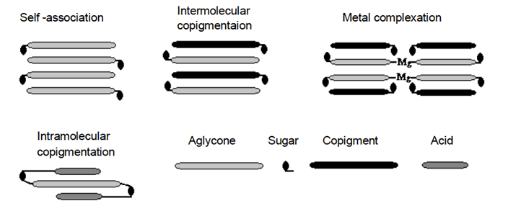
Figure 1: Blue colour in flower petals is caused by anthocyanins, which are members of flavonoid class metabol.
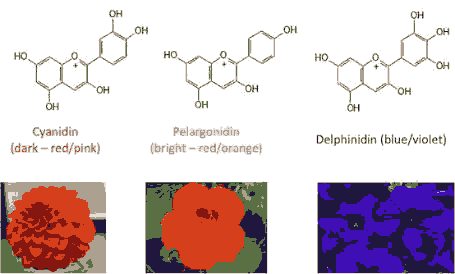
Figure 2: Chemical structures of the three main types of anthocyanins.
Molecular basis
Anthocyanin biosynthesis pathway is now well known and most of the enzyme was characterised. In the formation of blue pigments a few enzymes have particularly important role. Those enzymes are especially flavonoid 3'5'-hydroxylase (F3'5'H) and dihydroflavonol 4-reductase (DFR).
The flavonoid 3'5'H-hydroxylase is responsible for introduction of second and third hydroxyl group in the B-ring of dihydrokaempferol (DHK) or naringenin which are regarded as main substrates of the reaction. Product of the reaction with DHK is dihydromyricetin (DHM), precursor for synthesis of all delphinidin type anthocyanin. Enzyme is a member of cytochrome P450 protein family (P450s). It is a very diverse group of heme-containing oxidases, which catalyse NADPH- or NADH-dependent oxidation. F3'5'H was classified into CYP75A subfamily.This enzyme this is regarded as necessary for the blue pigment formation.
Dihydroflavonol 4-reductase is the oxidoreductase that catalyses in the presence of NADPH the stereospecific reduction of the keto group in position 4 of dihydroflavonols producing colourless leucoanthocyanidins as a precursor for anthocyanin formation. Enzyme can show substrate specificity with respect to the B-ring hydroxylation pattern of the dihydroflavonol and can therefore have an influence on the type of formed anthocyanin. For the blue pigment formation, necessary is enzyme, which accept DiHydroMyricetin(DHM) as a substrate. Product of DFR reaction with DHM in the following steps of the pathway is converted to delphinidin type blue pigments shown in Figure 3.
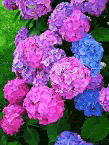
Figure 3: Hydrangea with different flower colours.
In 2004, Japanese company Suntory produced a blue rose, named Applause1. Further hybridizing advancements, scientific study, and possibly further genetic engineering will be necessary toconcentrate these natural genetic factors and cofactors before roses will be able to come in deep shades of true blue shown in Figure 4.

Figure 4: Blue rose cultivar "Applause.
Pigments by various production methods
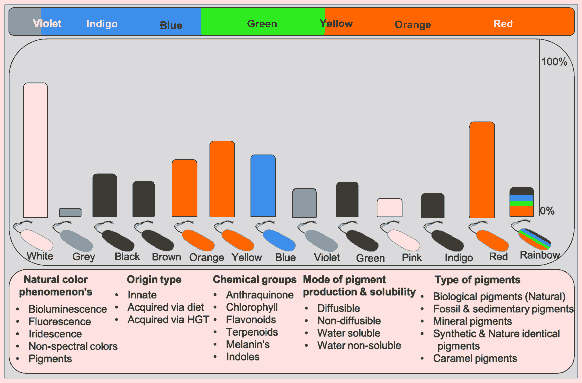
Figure 5: Various pigments and production methods.
A wide array of pigmented microbes seen in nature. The abundance of the type of pigmented bacteria is depicted in bars based on the available literature. Rainbow bacteria are iridescent Figure 5. Classification of pigments based on various aspects of biochromes. Chlorophyll pigments are not included in the data as they are ubiquitous. HGT: Horizontal gene transfer.
Pigment of marine algae
Algae contain a variety of pigments.The three main classes of pigments are chlorophyll, carotenoids (carotene and xanthophyll) and phycobilis (phycocyanin and phycoerythrin). Phycocyanin and phycoerythrin belong to the main class of phycobilins photosynthetic pigments, while fucoxanthin and peridinin belong to the carotenoid group of photosynthetic pigments. Macroalgae and microalgae (including cyanobacteria) provide a variety of metabolites, including pigments shown in Figure 6.
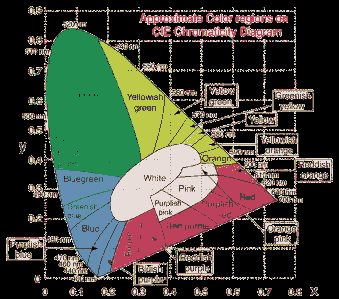
Figure 6: Approximate Color regions on CIE Chromaticity Diagram.
Structure of phycobiliproteins
The phycobiliproteins are antennae protein pigmentsfound in cyanobacteria, rhodophytes,cryptomonadsandcyanelles (Glazer, 1994). The phycobiliproteinsarepresent as phycobilisomes anchored on the thylakoidmembranes and lie adjacent to the photosynthetic reaction centre of the PS II in cyanobacteria and red algae. These chromoproteins are classified into 3 groupsbasedon the presence of different chromophoresamongthem (Gantt, 1994; Glazer, 1985; Zilinskas, 1986; Rowan, 1989; Sidler 1994; Mac Coll, 1998; Ducret et al., 1998). These groups are (1) Phycoerythrin (PE) ?max480 nm-570 nm; (2) Phycocyanin (PC) ?max 590-630nm and Phycoerythrocyanin (PEC) ?max 630-665 nm(3) Allophycocyanin (APC) ?max 620-665 nm. Core ofphycobiliproteinsiscomposed of allophycocyanin fromwhich arise six rods of varying length consisting of phycocyanins to the proximal side of the core and phycoerythrins to the distal side of the core.
Features of the nine structural colors of green algae
The mitochondria of green algae have nine colors of information genetically.The nine structural colors of green algae survive in dry, bleached and blackened conditions.Green algae survive above 50 degrees celsius in seawater, and they undergo an irregular chromaticity transformation under the influence of UV rays.
What are the features of green seaweed?
Green seaweed has a main color of green and has eight colors shown in Figure 7.
The chromaticity transformation of green seaweed.
A) Green-Blue-Yellow-White-Pink-Red-red Purple-Brown-Black-Green
B) Green-white-pink-red-purple-brown-black-Green
C) Green-white-pink-red-purple-brown-Green
D) Green-white-pink-red-purple-Green
E) Green-white-pink-red-Green
F) Green-white-pink-Green Green-white-Green.
G) Green seaweed is sometimes changing in chromatic depending on environmentalconditions.(Green-Brown-Green,Green-Brown-White-Green, Green-Blue-Green).
H) This is when green seaweed is in the upper layer of seawater.
I) Green-Yellow-White-Green.Green-Yellow-Green
J) The various colors return to green even if the color is changed.(Similar to a chameleon).
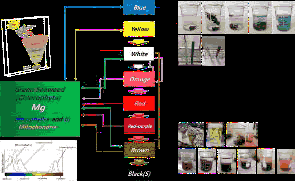
Figure 7: The process diagram for the separation of pigments and transformation of the chromaticity of the nine colors of the green algae.
Materials and Methods
Green algae (Ulvapertusa, prolifera, etc) can be used in aquariums and plastic orafter putting it in a glass bottle, I installed it outside where it was exposed to UV rays. Green seaweeds were dried and discolored due to evaporation of seawater during the four seasons, and complex pigments were living with irregular color changes regardless of the season shown in Figure 8-10.
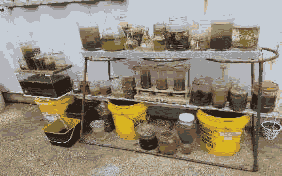
Figure 8: Transformation and Observation of Chromaticity of Green Seaweed Planted in Basil and Period February 2019-May 13. 2021.

Figure 9: This is the process of transformation the chromaticity by putting green algae into the aquarium. As seawater evaporates from the aquarium, it is slowly mixed in various colors. It appears in green-sky blue-purple-blue-dark blue and green.
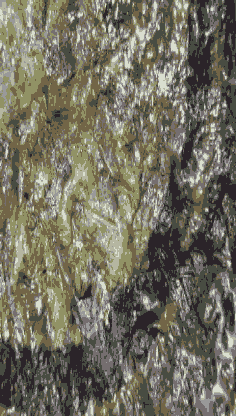
Figure 10: Under the influence of ultraviolet rays, various structural colors of green algae are transformed in the upper layer. Green, pink, red- purple, white, radish-brown are displayed.
Results and Discussion
Mixed colors of green seaweed: Green, red-purple, Blue
Description of the experiment.This is the blended color of the green algae whose chromaticity has been transformed.After putting the dried algae into fresh water, the pigment is slowly discharged from bright blue to blue.Green algae release all of the photosynthesized blue pigments. If the algae does not show red-purple, all blue pigments are recovered shown in Figure 11-13.

Figure 11: The process of naturally separating pigments by putting dark blue green seaweed in the water.
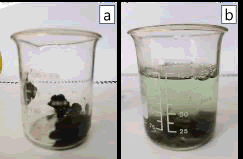
Figure 12: After separating the blue pigment, seaweed is being transformed to green.
The unstable state of the blue pigments.The pigment is reflected in sunlight and looks blue and red-purple.
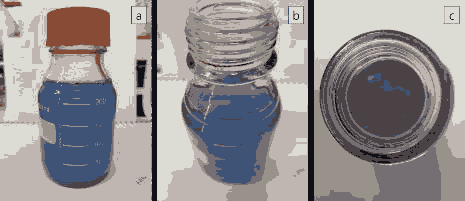
Figure 13: a) Blue b-c) Blue and red-Purple.
Mixed colors of green seaweed: Green, red-purple, blue
These are the colors of the irregular algae of photosynthesis. In a white ceramic container, add algae and water to separate the pigment. As the green pigment was discharged, the blue pigment was discharged afterwards, and they are mixed with each other. The blue round line on the ceramic bowl is a blue pigment that has been dried after the moisture has evaporated shown in Figure 14.

Figure 14: Green pigments are being emitted from green and blue and Blue pigments are being emitted.
Mixed colors of green seaweed: Green, red-purple, blue
After placing the dried algae in a ceramic bowl with water, the color of pigment discharge from the algae appears bright green, bluish green, and light blue. Their colors are what you see when algae and pigment are present together. If you put the pigment separated from the algae into a glass tube, it looks indigo. The pigment appears in indigo and red-purple colors by the refraction of light shown in Figure 15.
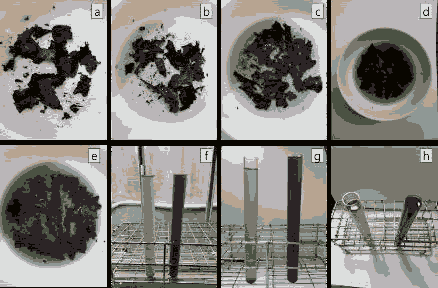
Figure 15: a) Dried algae. b,c) A bright green pigment is being discharged. d) Green and Blue. e) Dark bluef. f,g) Photos taken indoors and outdoors. Left: Green pigment discharged from "c". Right: Indigo pigment released from "e". h) Indigo pigment and reddish purple.
Conclusion
Due to changes in the global environment and warming, many birds in the oceans and seas sometimes float and migrate. Eco-friendly pigments can be produced by utilizing the resources that are being disposed of as a resource for life on the planet.The pigments of marine algae are diverse and can be utilized as a useful resource to reduce pollution of the ecological environment by toxic substances and heavy metals generated from dyeing wastewater produced as chemical products.In addition, until now, education and research in the field of marine algae life science have been very lacking.Teachers who teach marine biology education must learn more accurately, and young students learning education are the future protagonists, and as they grow, we will continue to practice and protect the life and environment of our planet.
References
- Chris,J., Chandler Bodo, D., Juliet, B., Silvia, V. (2017). Structural color in marine algae. The copyright line of this paper was changed 7 March 2017 after initial publication.
- Tanveer, A., Lubna, N., Ahmed, H. (2018). Extraction of natural pigments from marine algae. Journal of Agricultural and Marine Sciences, 23(1), 81–91.
- Alberta, N., Dominic,A., Taiwo, O. (2018). Recovery and utilization of seaweed pigments in food processing. Current Opinion in Food Science.
- Barkia, I., Saari, N., Manning, S.R. (2019). Microalgae for high-value products towards human health and nutrition. Mar. Drugs, 17, 304.
- Pangestuti, R., Kim, S.K. (2011). Neuroprotective effects of marine algae. Mar. Drugs, 9, 803–818.
- Suganya, T., Varman, M., Masjuki, H.H., Renganathan, S.(2016). Macroalgae and microalgae as a potential source for commercial applications along with biofuels production: A biorefinery approach. Renew. Sustain. Energy Rev, 55, 909–941.
- Mouritsen,O.G., Rhatigan, P., Pérez-Lloréns,J. (2018). The rise of seaweed gastronomy: Phycogastronomy. Bot, 62, 195–209.
- González-Torres, L., Churruca, I., Schultz Moreira, A.R., Bastida, S., Benedi, J., Portillo, M.P. (2012). Effects of restructured pork containing Himanthalia elongata on adipose tissue lipogenic and lipolytic enzyme expression of normo- and hypercholesterolemic rats. J. Nutr. Nutr, 5, 158–167.
- Olivero-David, R., Schultz-Moreira, A., Vázquez-Velasco, M., González-Torres, L., Bastida, S.,… & Sánchez-Muniz, F.J. (2011).Effects of nori-and wakame-enriched meats with or without supplementary cholesterol on arylesterase activity, lipaemia and lipoproteinaemia in growing Wistar rats. Br. J. Nutr, 106, 1476–1486.
- Gammone, M.A., Orazio, N. (2015). Anti-obesity activity of the marine carotenoid fucoxanthin. Drugs, 13, 2196–2214.
- Park, M.H., Jeon, Y.J., Kim, H.J., Han, J.S. (2013). Effect of diphlorethohydroxycarmalol isolated from Ishige okamurae on apoptosis in 3 T3-L1 preadipocytes. Phytother. Res, 27, 931–936.
- Garcimartín, A., Benedí, J., Bastida, S., Sánchez-Muniz, F.J. (2015). Aqueous extracts and suspensions of restructured pork formulated with Undaria pinnatifida, Himanthalia elongata and Porphyra umbilicalis distinctly affect the in vitro a-glucosidase activity and glucose diffusion. LWT Food Sci. Technol, 64, 720–726.
- Ali, M.Y., Kim, D.H., Seong, S.H., Kim, H.R., Jung, H.A., Choi, J.S. (2017).A-Glucosidase and protein tyrosine phosphatase 1B inhibitory activity of plastoquinones from marine brown alga Sargassum serratifolium.Drugs, 15, 368.
- Schultz Moreira, A.R., Olivero-David, R., Vázquez-Velasco, M., González-Torres, L., Benedi, J., Bastida, S., Sánchez-Muniz, F.J. (2014).Protective effects of sea spaghetti-enriched restructured pork against dietary cholesterol: Effects on arylesterase and lipoprotein profile and composition of growing rats. J. Med, 17, 921–928.
- Maeda, H., Fukuda, S., Izumi, H., Saga, N. (2018). Anti-oxidant and fucoxanthin contents of brown alga ishimozuku (Sphaerotrichia divaricata) from the west coast of Aomori, Japan. Mar. Drugs, 16, 255.
- Maeda, H., Kanno, S., Kodate, M., Hosokawa, M., Miyashita, K. (2015). Fucoxanthinol, metabolite of fucoxanthin, improves obesity-induced inflammation in adipocyte cells. Drugs, 13, 4799–48.
- Dong, X., Bai, Y., Xu, Z., Shi, Y., Sun, Y.,… & Qi, H. (2019). Phlorotannins from Undaria pinnatifida sporophyll: Extraction, antioxidant, and anti-inflammatory activities. Drugs, 17, 434.
- Lee, D., Nishizawa, M., Shimizu, Y., Saeki, H. (2017). Anti-inflammatory effects of dulse (Palmaria palmata) resulting from the simultaneous water-extraction of phycobiliproteins and chlorophyll a. Food Res. Int, 100, 514–521.
- Deethae,A., Peerapornpisal, Y., Pekkoh, J., Sangthong, P., Tragoolpua, Y. (2018). Inhibitory effect of Spirogyra spp. algal extracts against herpes simplex virus type 1 and 2 infection. J. Appl. Microbiol, 124, 1441–1453.
- Dinesh, S., Menon, T., Hanna, L.E., Suresh, V., Sathuvan, M., Manikannan, M. (2016). In vitro anti-HIV-1 activity of fucoidan from Sargassum swartzii. Int. J Biol. Macromol, 82, 83–88.
- Karpinski, T.M., Adamczak, A. (2019). Fucoxanthin: An antibacterial carotenoid. Antioxidants., 8, 239.
- Lu, W.J., Lin, H.J., Hsu, P.H., Lai, M., Chiu, J.Y., Lin, H.T.V. (2019). Brown and red seaweeds serve as potential efflux pump inhibitors for drug-resistant Escherichia coli. Evid Based Complement. Altern. Med, 1836982.
- Capillo, G., Savoca, S., Costa, R., Sanfilippo, M., Rizzo, C.,… &Spanò, N., et al. (2018). New insights into the culture method and antibacterial potential of Gracilaria gracilis.Drugs., 16, 492.
- Martin, L.J. (2015). Fucoxanthin and its metabolite fucoxanthinol in cancer prevention and treatment. Mar. Drugs, 13, 4784–4798.
- Wang, J., Ma, Y., Yang, J., Jin, L., Gao, Z.,… & Zou X. (2019). Fucoxanthin inhibits tumour-related lymphangiogenesis and growth of breast cancer. J. Cell. Mol. Med, 23, 2219–2229.
- Liu, Q., Wang,Y., Cao, M., Pan, T., Yang, Y.,… & Liu G. (2015). Anti-allergic activity of R-phycocyanin from Porphyra haitanensis in antigen-sensitized mice and mast cells. Int. Immunopharmacol, 25, 465–473.
- Chen, Y., Lin, H., Li, Z., Mou, Q. (2015). The anti-allergic activity of polyphenol extracted from five marine algae. J. Ocean Univ. China, 14, 681–684.
- Lin, J., Huang, L., Yu, J., Xiang, S., Wang, J.,… & Wang, Q. (2016).Fucoxanthin, a marine carotenoid, reverses scopolamine-induced cognitive impairments in mice and inhibits acetylcholinesterase in vitro. Mar. Drugs, 14, 67.
- Silva, J., Alves, C., Pinteus, S., Mendes, S., Pedrosa, R. (2018). Neuroprotective effects of seaweeds against 6-hydroxidopamine-induced cell death on an in vitro human neuroblastoma model.BMC Complement. Altern. Med, 18, 58.
- Shimazu, T., Kuriyama, S., Hozawa, A., Ohmori, K., Sato, Y.,… &Tsuji, I. (2007).Dietary patterns and cardiovascular disease mortality in Japan: A prospective cohort study. Int. J. Epidemiol, 36, 600–609.
- Ikeda, K., Kitamura, A., Machida, H., Watanabe, M., Negishi, H., Hiraoka J., Nakano T. (2003). Effect of Undaria pinnatifida (Wakame) on the development of cerebrovascular diseases in stroke-prone spontaneously hypertensive rats. Clin. Exp. Pharmacol. Physiol, 30, 44–48.
- Azeem, M., Iqbal, N., Mir, R.A., Adeel, S., Batool, F., Khan, A.A., Gul S. (2019). Harnessing natural colorants from algal species for fabric dyeing: A sustainable eco-friendly approach for textile processing. J. Appl. Phycol, 31, 3941–3948.
- Palabiyik, I., Durmaz, Y., Öner,B., Toker, O.S., Coksari, G., Konar, N., Tamtürk, F. (2018). Using spray-dried microalgae as a natural coloring agent in chewing gum: Effects on color, sensory, and textural properties. J. Appl. Phycol, 30, 1031–1039.
- El-Khatib, E., Ali, N.F., El-Mohamedy, R. (2016). Enhancing dyeing of wool fibers with colorant pigment extracted from green algae. J. Chem. Pharm. Res, 8, 614–619.
- Wang, H.D., Li, X.C., Lee, D.J., Chang, J.S. (2017). Potential biomedical applications of marine algae. Bioresour. Technol, 244, 1407–1415.
- Singh, S., Kate, B.N., Banerjee, U.C. (2005). Bioactive compounds from cyanobacteria and microalgae: An overview. Crit. Rev. Biotechnol, 25, 73–95.
- Kim, S.K., Pangestuti, R. (2011). Biological activities and potential health benefits of fucoxanthin derived from marine brown algae. Adv. Food Nutr. Res, 64, 111–128.
- Senge, M.O., Ryan, A.A., Letchford, K.A., MacGowan, S.A., Mielke, T. (2014). Chlorophylls, symmetry, chirality, and photosynthesis.Symmetry, 6, 781–843.
- Poojary, M.M., Barba, F.J., Aliakbarian, B., Donsì, F., Pataro, G., Dias, D.A., Juliano, P. (2016). Innovative alternative technologies to extract carotenoids from microalgae and seaweeds.Mar. Drugs, 14, 214.
- Matsuno, T. (2001). Aquatic animal carotenoids.Fish. Sci, 67, 771–783.
- Glazer, A.N. (1994). Phycobiliproteins—A family of valuable, widely used fluorophores. J. Appl. Phycol, 6, 105–112.
- Bryant,D.A., Guglielm,i G., Marsac, N.T.D., Castets, A.M., Cohen-Bazire, G. (1979).The structure of cyanobacterial phycobilisomes: A model. Arch. Microbiol, 123, 113–127.
- Pimentel, F.B., Alves, R.C., Rodrigues, F., Oliveira, M.B.P.P. (2018). Macroalgae-derived ingredients for cosmetic industry—An update. Cosmetics, 5, 2.
- Connan, S. (2015). Spectrophotometric assays of major compounds extracted from algae.Methods Mol. Biol., 1308, 75–101.
- Fabrowska, J., Messyasz,B., Szyling, J., Walkowiak, J., L eska, B.(2018). Isolation of chlorophylls and carotenoids from freshwater algae using different extraction methods.Phycol. Res, 66, 52–57.
- Alam, T., Najam, L., Al Harrasi, A. (2018). Extraction of natural pigments from marine algae.J. Agric. Marine. Sci, 23, 81–91.
- Wiltshire, K.H., Boersma, M., Möller, A., Buhtz, H.(2000). Extraction of pigments and fatty acids from green alga Scenedesmus obliquus (Chlorophyceae).Aquat. Ecol, 34, 119–126.
- Inskeep, W.P., Bloom, P.R. (1985). Extinction coefficients of Chlorophyll a and b in N,N-Dimethylformamide and 80% Acetone. Plant. Physiol, 77, 483–485.
- Ritchie R.J. (2006). Consistent sets of spectrophotometric chlorophyll equations for acetone, methanol and ethanol solvents. Photosynth. Res, 89, 27–41.
- Ritchie, R.J. (2008). Universal chlorophyll equations for estimating chlorophylls a, b, c, and d and total chlorophylls in natural assemblages of photosynthetic organisms using acetone, methanol, or ethanol solvents. Photosynthetica, 46, 115–126.
- Seely, G.R., Duncan, M.J., Vidaver, W.E. (1972). Preparative and analytical extraction of pigments from brown algae with dimethyl sulfoxide. Marine Biol, 12, 184–188.
- Beer, S., Eshel, A. (1985). Determining phycoerythrin and phycocyanin concentrations in aqueous crude extracts of red algae. Marine Freshw. Res, 36, 785–792.
- Lawrenz, E., Fedewa, E.J., Richardson, T.L. (2011).Extraction protocols for the quantification of phycobilins in aqueous phytoplankton extracts. J. Appl. Phycol, 23, 865–871.
- Munier, M., Jubeau, S., Wijaya, A., Morancais, M., Dumay, J., Marchal, L., Jaouen, P., Fleurence, J. (2014).Physicochemical factors affecting the stability of two pigments: R-phycoerythrin of Grateloupia turuturu and B-phycoerythrin of Porphyridium cruentum. Food. Chem, 150, 400–407.
- Hussein, M.H., El-Naggar, N.E., El-Sawah, A.A. (2017). Extraction, Purification and Spectroscopic Characterization of Phycobiliproteins Extracted from Some Nostoc Spp. J. Agric. Chem. Biotechn, 8, 261–264.
- Thoisen, C., Hanse, B.W., Nielsen, S.L. (2017). A simple and fast method for extraction and quantification of cryptophyte phycoerythrin. MethodsX, 4, 209–213.
- Pereira, T., Barroso, S., Mendes, S., Amaral, R.A., Dias, J.R.,… &Gil M.M. (2020). Optimization of phycobiliprotein pigments extraction from red algae Gracilaria gracilis for substitution of synthetic food colorants. Food. Chem, 321, 126688.
- Floc’h, J., Pajot, R., Mouret, V. (1996). Undaria pinnatifida (Laminariales, Phaeophyta) 12 years after its introduction into the Atlantic Ocean.Hydrobiology, 326, 217–222.
- Veiga, P., Torres, A.C., Rubal, M., Troncoso, J., Soupa-Pinto, I. (2014).The invasive kelp Undaria pinnatifida (Laminariales, Ochrophyta) along the north coast of Portugal: Distribution model versus field observations. Mar. Pollut. Bull, 84, 363–365.
- Rezzoum, N., Mouradi,A., Givernaud, T., Bennasser, L. (2017). Temporal variation of Laminaria ochroleuca Bachelot de la Pylaie (Laminariales, Phaeophyta) biomass on the Moroccan Atlantic coast: Implication for commercial harvesting. Algol. Stud, 153, 1–15.
- Pimentel, F., Cermeño, M., Kleekayai,T., Harnedy P.A., FitzGerald R.J., Alves R.C., Oliveira M.B.P.P. (2020). Effect of in vitro simulated gastrointestinal digestion on the antioxidant activity of the red seaweed Porphyra dioica. Food Res. Int, 136, 109309.
- Soni, R.A., Sudhakar, K., Rana, R.S. (2019). Comparative study on the growth performance of Spirulina platensis on modifying culture media. Energy Rep, 5, 327–336.
- Syad, A.N., Pandian, S., Kasi, P.D. (2013). Seaweeds as nutritional supplements: Analysis of nutritional profile, physicochemical properties and proximate composition of G. acerosa and S. wightii. Biomed. Prev. Nutr, 3, 139–144.
- Sartory, D.P., Grobbelaar, J.U. (1984). Extraction of chlorophyll a from freshwater phytoplankton for spectrophotometric analysis. Hydrobiologia, 114, 177–187.
- Dasgupta, C.N. (2015). Algae as a source of phycocyanin and other industrially important pigments. In Algae Biorefinery: An Integrated Approach, 1st edition; Das, D., Ed.; Springer International Publishing: Cham, Switzerland,253–276.
- Pither, R.J. (2003).Canning-quality changes during canning. In Encyclopedia of Food Sciences and Nutrition, 2nd edition.; Caballero B., Finglas P., Toldra F., Eds.; Academic Press: London, UK, 845–851.
- Brereton, R.G., Rahmani, A., Liang, Y., Kvalheim, O.M. (1994). Investigation of the allomerization reaction of chlorophyll a: Use of diode array HPLC, mass spectrometry and chemometric factor analysis for the detection of early products. Photochem. Photobiol, 59, 99–110.
- Yoshikawa, H., Hirano, A., Arakawa, T., Shiraki, K.(2012). Mechanistic insights into protein precipitation by alcohol. Int. J. Biol. Macromol, 50, 865–871.
- Schilder, G., Schlagenhauf, A., Schneditz, D., Scharnagl, H., Ribitsch, W.,… &Horina, J.H. (2013). Ethanol causes protein precipitation—New safety issues for catheter locking techniques. PLoS ONE, 8, e84869.
- Pereira, L., Neto, J.M. (2014).Marine algae: Biodiversity, Taxonomy, Environmental Assessment, and Biotechnology, 1st edition; CRC Press: Boca Raton, FL, USA,1–398.
- Takaichi, S. (2011). Carotenoid in algae: Distributions, biosynthesis and functions. Mar. Drugs, 9, 1101–1118.
- Guedes, A.C., Amaro, H.M., Malcata, F.X. (2011). Microalgae as sources of carotenoids. Mar. Drugs, 9, 625–644.
- Lalegerie, F., Gager, L., Stiger-Pouvreau, V., Connan, S. (2020).The stressful life of red and brown seaweeds on the temperate intertidal zone: Effect of abiotic and biotic parameters on the physiology of macroalgae and content variability of particular metabolites. In Advances in Botanical Research—Seaweeds around the World: State of Art and Perspectives, 1st edition; Bourgougnon, N., Ed.; Elsevier Science & Technology: London, UK,95.
- Lordan,S., Ross, R.P., Stanton, C. (2011). Marine bioactives as functional food ingredients: Potential to reduce the incidence of chronic diseases. Mar. Drugs, 9, 1056–1100.
- Zerrifi, S.E.A., Khalloufi, F.E., Oudra, B., Vasconcelos, V. (2018). Seaweed bioactive compounds against pathogens and microalgae: Potential uses on pharmacology and harmful algae bloom control. Mar. Drugs, 16, 55.
Author Info
Man Gil Ahn*Citation: Ahn, M.G. (2021). Separation and Method of Natural Pigments by Chromaticity Transformation of Green Seaweed. Ukrainian Journal of Ecology, 11(2), 37-46.
Received: 14-May-2021 Accepted: 11-Jun-2021 Published: 29-Jun-2021
Copyright: © This work is licensed under a Creative Commons Attribution 4.0. License
Competing interests: The authors have declared that no competing interests exist.
Sources of funding : GB´s PhD-project on ethical challenges and decision-making in nursing homes has been financially supported by the Norwegian Extra Foundation for Health and Rehabilitation through EXTRA funds (grant no. 2008/2/0208).
